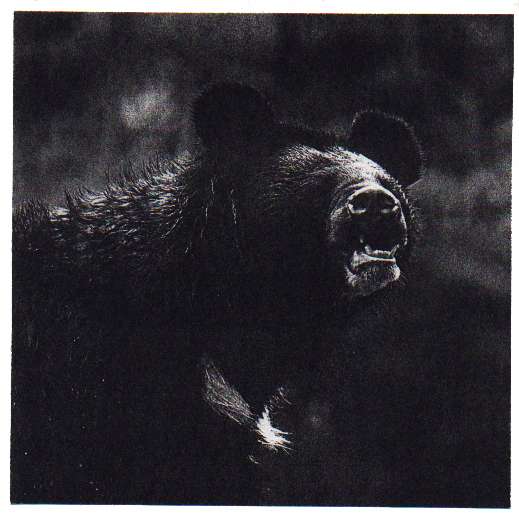 Marshall
Cultural Atlas Marshall
Cultural Atlas
This collection of student work is from
Frank Keim's classes. He has wanted to share these works for others
to use as an example of Culturally-based curriculum and documentation. These
documents have been OCR-scanned. These are available
for educational use only.

Asiatic Black Bear
Asiatic Black Bear
(Selenarotos thibetanus)
There are about 12 different kinds of bears in the world, but the
one that I think stands out the most is the Asiatic Black bear. This
bear lives in the southern part of Asia. Its range is from the
northern tip of China to the central part of Russia. Although this
bear isn't very big, it is very fierce. It is about five feet tall
and 1.5 meters in length. It weighs about 250-300 pounds depending
upon where it is located in Asia. The northern Asian Black bears are
a little bit larger than the ones south of them. This is because of
the colder climate. They need the extra bulk to stay warm. These
bears have three different names: Moon bear, Himalayan bear, and
Asiatic Black bear. The most common name they go by is Asiatic Black
bear.
Most of the time these bears are calm and gentle, but they are
known to be fierce as well. There are reports that this bear has
killed cattle, sheep, and on occasion man. The bear probably didn't
attack the man on purpose because they are afraid of man. It was most
probably a provoked attack.
When winter comes to Asia, the Moon bear finds a den and falls
asleep. This bear doesn't really hibernate though because it doesn't
sleep very long. It is special because before it goes to sleep, it
makes its own bed to sleep on out of twigs and grass.
This bear mostly eats meat and vegetation. During its life time it
may have 15 cubs. It is also very fond of honey. When it finds honey
in the wild, it will stop at nothing to get the honey from the bees.
This bear has a population of about 25,000 in Asia. The future of
this bear looks great.
Resources: Ecyclopedia B.
By: Leslie Hunter Jr.
Bear Fire
Stories and Poems
about Bears
|
by Marshall High School
Language Arts Classes
Spring, 1992
Produced
by
Information
about Bears
Creative
Stories from the Imagination
True
Stories from Experience
Poems
Christmastime Tales
Stories real and imaginary about Christmas, Slavik, and the New Year
Winter, 1996 |
Christmastime Tales II
Stories about Christmas, Slavik, and the New Year
Winter, 1998 |
Christmastime Tales III
Stories about Christmas, Slavik, and the New Year
Winter, 2000 |
| Summer Time Tails 1992 |
Summertime Tails II 1993 |
Summertime Tails III |
| Summertime Tails IV Fall, 1995 |
Summertime Tails V Fall, 1996 |
Summertime Tails VI Fall, 1997 |
| Summertime Tails VII Fall, 1999 |
Signs of the Times November 1996 |
Creative Stories From Creative Imaginations |
| Mustang Mind Manglers - Stories of the Far Out,
the Frightening and the Fantastic 1993 |
Yupik Gourmet - A Book of
Recipes |
|
| M&M Monthly |
|
|
| Happy Moose Hunting! September Edition 1997 |
Happy Easter! March/April 1998 |
Merry Christmas December Edition 1997 |
| Happy Valentine’s
Day! February Edition
1998 |
Happy Easter! March/April Edition 2000 |
Happy Thanksgiving Nov. Edition, 1997 |
| Happy Halloween October 1997 Edition |
Edible and Useful Plants of Scammon
Bay |
Edible Plants of Hooper Bay 1981 |
| The Flowers of Scammon Bay Alaska |
Poems of Hooper Bay |
Scammon Bay (Upward Bound Students) |
| Family Trees and the Buzzy Lord |
It takes a Village - A guide for parents May 1997 |
People in Our Community |
| Buildings and Personalities of
Marshall |
Marshall Village PROFILE |
Qigeckalleq Pellullermeng ‘A
Glimpse of the Past’ |
| Raven’s
Stories Spring 1995 |
Bird Stories from Scammon Bay |
The Sea Around Us |
| Ellamyua - The Great Weather - Stories about the
Weather Spring 1996 |
Moose Fire - Stories and Poems about Moose November,
1998 |
Bears Bees and Bald Eagles Winter 1992-1993 |
| Fish Fire and Water - Stories about fish, global warming
and the future November, 1997 |
Wolf Fire - Stories and Poems about Wolves |
Bear Fire - Stories and Poems about Bears Spring,
1992 |
|